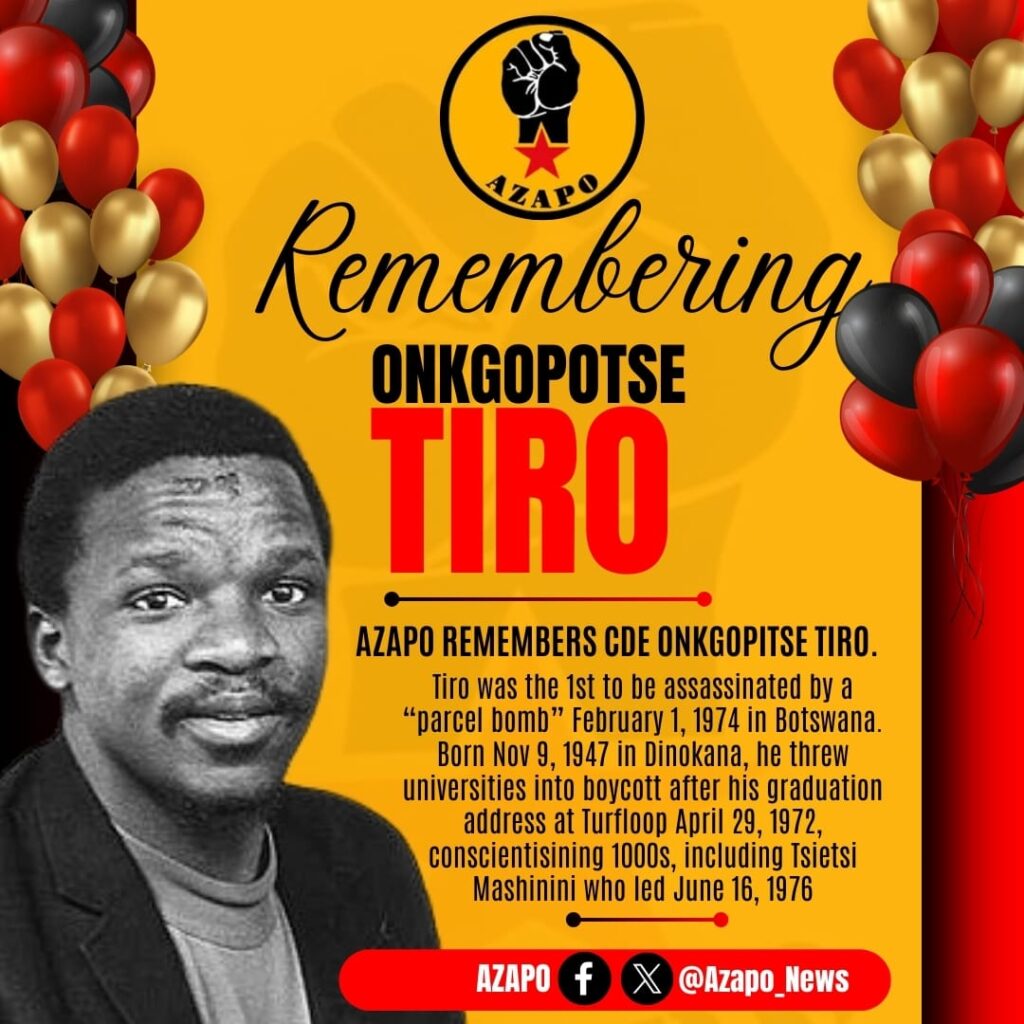
Many male political activists, especially those belonging to the PAC and AZAPO, affectionately refer to one another as “Son of the Soil.”
But in reality, not many of them have achieved what the original son of the soil Okgopotse Abram Tiro has managed to achieve in his very short life.
Tiro was a fearless member of the Black Consciousness Movement of Azania; an organisation of which he was a founder member.
Some of the prominent founder members of the Black Consciousness Movement of Azania include legendary Steve Biko, Professor Barney Pityana, former Cope leader Terror Lekota and Don Nkadimeng.
This was in 1969 at the University of the North, commonly known as Turfloop University at the time.
After the country’s liberation the university came to be known as the University of Limpopo and AZAPO stalwarts are still baffled to this day that this institution of higher learning has not been renamed after Tiro.
This as his speech during the 29 April 1972 graduation ceremony, now known as “The Turfloop Testimony,” ruffled the feathers of the then white university authorities and the apartheid regime on the one hand, while on the other it conscientised his fellow graduates to revolt and agitate for the fall of the white racist South African government.
One of the questions he posed to his fellow graduates during his speech was as follows:
“Of what use will your education be if it is not linked to the entire continent of Africa?”
He then went on to answer the selfsame question as follows:
“It is meaningless.”
This shows that Tiro was an advocate and pioneer of decolonised education long before it could be fashionable.
He was subsequently expelled from Turfloop University as a result of the aforesaid speech.
Be that as it may, the expulsion of Tiro didn’t bring the university authorities “the peace” that they desired because Turfloop University became a battle ground between aspiring black intellectuals and the apartheid forces, with intermittent class boycotts, violence and protests being the order of the day until 1994 when South Africa fell under a democratic dispensation.
One of the quotable quotes attributed to Tiro as he went along his trajectory of political activism goes:
“It is better to die for an idea that will live, rather than live for an idea that will die.”
As an indication that Tiro was, if needs be prepared to die in the fight for the reclamation of the land by its rightful owners, for the total liberation of black people in the land of his forebears, and for the eradication of the apartheid regime, he famously said the following:
“There is no struggle without casualties.”.
In 1973 he went to teach History at the Morris Isaacson High School, where he radicalised and gave political enlightenment to students like Tsietsi Mashinini, Murphey Morobe and Khotso Seatlholo.
The trio would later on in life go on to become leaders of the June 1976 Soweto Students Uprisings.
Onkgopotse Tiro skipped the country in the selfsame 1973; sensing that the apartheid security forces were on the brink of eliminating him.
He went to live in exile in neighbouring Botswana but on 1 February 1974 he was killed by a letter bomb which was undoubtedly sent to him by agents working for the apartheid regime.
According to reports at the time, his whole body was torn into shreads by the potent letter bomb.
But Tiro’s resolve and ideas to fight against the apartheid government lived after him because the 1976 riots, which are renowned as a catalyst that finally triggered the end of apartheid, were inspired partly by his death, with students seeking revenge for his demise.
Tiro was born in the tiny village of Dinokana in what today is known as the North West Province and was only 28 years at the time of his assassination.
Saturday the 1st of February 2025 marked the 51st anniversary of his death.
Tshwane Talks readers have been able to read stories in this publication for free for over two years now. We still want our readers to access our stories for free, but we are asking those among our readers who can afford it to contribute at least R30 a month to cover some of the costs of publishing this independent, non-aligned online newspaper which gives a voice to all sectors of society irrespective of race, colour, creed, religion, or political affiliation. You may make your contribution by depositing at least R30 a month into Tshwane Talks' bank account. Details are as follows:
Bank Details
Bank: Standard Bank
Account Number: 10225548834
Account Type: Cheque Account